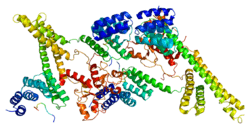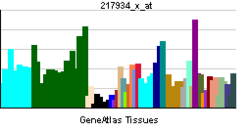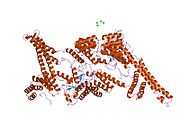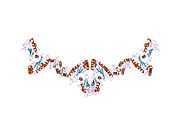STUB1
STUB1 (STIP1 homology and U-Box containing protein 1), also known as CHIP (C terminus of HSC70-Interacting Protein), is a human gene.[1][2]
Function
The CHIP protein encoded by this gene binds to and inhibits the ATPase activity of the chaperone proteins HSC70 and HSP70 and blocks the forward reaction of the HSC70-HSP70 substrate-binding cycle.[2] In addition, CHIP possesses E3 ubiquitin ligase activity and promotes ubiquitylation.[3] CHIP enhances HSP70 induction during acute stress and also mediates its turnover during the stress recovery process. Hence CHIP appears to maintain protein homeostasis by controlling chaperone levels during stress and recovery.[4]
Mutations in STUB1 cause ataxia .Synofzik, M; Schüle, R; Schulze, M; Gburek-Augustat, J; Schweizer, R; Schirmacher, A; Krägeloh-Mann, I; Gonzalez, M; Young, P; Züchner, S; Schöls, L; Bauer, P (2014). "Phenotype and frequency of STUB1 mutations: Next-generation screenings in Caucasian ataxia and spastic paraplegia cohorts". Orphanet Journal of Rare Diseases 9 (1): 57. doi:10.1186/1750-1172-9-57. PMC 4021831. PMID 24742043.
Interactions
STUB1 has been shown to interact with C-Raf,[5] Parkin (ligase),[6] DNAJB1,[2] HSPA8,[2] RUNX2,[7] HSPA1A[2][6] and HSPA4.[2]
References
- ↑ "Entrez Gene: STUB1 STIP1 homology and U-box containing protein 1".
- ↑ 2.0 2.1 2.2 2.3 2.4 2.5 Ballinger CA, Connell P, Wu Y, Hu Z, Thompson LJ, Yin LY, Patterson C (1 June 1999). "Identification of CHIP, a Novel Tetratricopeptide Repeat-Containing Protein That Interacts with Heat Shock Proteins and Negatively Regulates Chaperone Functions". Mol. Cell. Biol. 19 (6): 4535–45. PMC 104411. PMID 10330192.
- ↑ Jiang J, Ballinger CA, Wu Y, Dai Q, Cyr DM, Höhfeld J, Patterson C (November 2001). "CHIP is a U-box-dependent E3 ubiquitin ligase: identification of Hsc70 as a target for ubiquitylation". J. Biol. Chem. 276 (46): 42938–44. doi:10.1074/jbc.M101968200. PMID 11557750.
- ↑ Qian SB, McDonough H, Boellmann F, Cyr DM, Patterson C (March 2006). "CHIP-mediated stress recovery by sequential ubiquitination of substrates and Hsp70". Nature 440 (7083): 551–5. doi:10.1038/nature04600. PMID 16554822.
- ↑ Dogan, Taner; Harms Gregory S; Hekman Mirko; Karreman Christiaan; Oberoi Tripat Kaur; Alnemri Emad S; Rapp Ulf R; Rajalingam Krishnaraj (Dec 2008). "X-linked and cellular IAPs modulate the stability of C-RAF kinase and cell motility". Nat. Cell Biol. (England) 10 (12): 1447–55. doi:10.1038/ncb1804. PMID 19011619.
- ↑ 6.0 6.1 Imai, Yuzuru; Soda Mariko; Hatakeyama Shigetsugu; Akagi Takumi; Hashikawa Tsutomu; Nakayama Kei Ichi; Takahashi Ryosuke (Jul 2002). "CHIP is associated with Parkin, a gene responsible for familial Parkinson's disease, and enhances its ubiquitin ligase activity". Mol. Cell (United States) 10 (1): 55–67. doi:10.1016/S1097-2765(02)00583-X. ISSN 1097-2765. PMID 12150907.
- ↑ Li, Xueni; Huang Mei, Zheng Huiling, Wang Yinyin, Ren Fangli, Shang Yu, Zhai Yonggong, Irwin David M, Shi Yuguang, Chen Di, Chang Zhijie (Jun 2008). "CHIP promotes Runx2 degradation and negatively regulates osteoblast differentiation". J. Cell Biol. (United States) 181 (6): 959–72. doi:10.1083/jcb.200711044. PMC 2426947. PMID 18541707.
Further reading
- Patterson C (2002). "A new gun in town: the U box is a ubiquitin ligase domain". Sci. STKE 2002 (116): PE4. doi:10.1126/stke.2002.116.pe4. PMID 11805346.
- Scanlan MJ, Chen YT, Williamson B et al. (1998). "Characterization of human colon cancer antigens recognized by autologous antibodies". Int. J. Cancer 76 (5): 652–8. doi:10.1002/(SICI)1097-0215(19980529)76:5<652::AID-IJC7>3.0.CO;2-P. PMID 9610721.
- Ballinger CA, Connell P, Wu Y et al. (1999). "Identification of CHIP, a Novel Tetratricopeptide Repeat-Containing Protein That Interacts with Heat Shock Proteins and Negatively Regulates Chaperone Functions". Mol. Cell. Biol. 19 (6): 4535–45. PMC 104411. PMID 10330192.
- Connell P, Ballinger CA, Jiang J et al. (2001). "The co-chaperone CHIP regulates protein triage decisions mediated by heat-shock proteins". Nat. Cell Biol. 3 (1): 93–6. doi:10.1038/35050618. PMID 11146632.
- Daniels RJ, Peden JF, Lloyd C et al. (2001). "Sequence, structure and pathology of the fully annotated terminal 2 Mb of the short arm of human chromosome 16". Hum. Mol. Genet. 10 (4): 339–52. doi:10.1093/hmg/10.4.339. PMID 11157797.
- Jiang J, Ballinger CA, Wu Y et al. (2001). "CHIP is a U-box-dependent E3 ubiquitin ligase: identification of Hsc70 as a target for ubiquitylation". J. Biol. Chem. 276 (46): 42938–44. doi:10.1074/jbc.M101968200. PMID 11557750.
- Demand J, Alberti S, Patterson C, Höhfeld J (2002). "Cooperation of a ubiquitin domain protein and an E3 ubiquitin ligase during chaperone/proteasome coupling". Curr. Biol. 11 (20): 1569–77. doi:10.1016/S0960-9822(01)00487-0. PMID 11676916.
- Imai Y, Soda M, Hatakeyama S et al. (2002). "CHIP is associated with Parkin, a gene responsible for familial Parkinson's disease, and enhances its ubiquitin ligase activity". Mol. Cell 10 (1): 55–67. doi:10.1016/S1097-2765(02)00583-X. PMID 12150907.
- Krackhardt AM, Witzens M, Harig S et al. (2002). "Identification of tumor-associated antigens in chronic lymphocytic leukemia by SEREX". Blood 100 (6): 2123–31. doi:10.1182/blood-2002-02-0513. PMID 12200376.
- Strausberg RL, Feingold EA, Grouse LH et al. (2003). "Generation and initial analysis of more than 15,000 full-length human and mouse cDNA sequences". Proc. Natl. Acad. Sci. U.S.A. 99 (26): 16899–903. doi:10.1073/pnas.242603899. PMC 139241. PMID 12477932.
- Cardozo CP, Michaud C, Ost MC et al. (2003). "C-terminal Hsp-interacting protein slows androgen receptor synthesis and reduces its rate of degradation". Arch. Biochem. Biophys. 410 (1): 134–40. doi:10.1016/S0003-9861(02)00680-X. PMID 12559985.
- Zhou P, Fernandes N, Dodge IL et al. (2003). "ErbB2 degradation mediated by the co-chaperone protein CHIP". J. Biol. Chem. 278 (16): 13829–37. doi:10.1074/jbc.M209640200. PMID 12574167.
- Shimura H, Schwartz D, Gygi SP, Kosik KS (2004). "CHIP-Hsc70 complex ubiquitinates phosphorylated tau and enhances cell survival". J. Biol. Chem. 279 (6): 4869–76. doi:10.1074/jbc.M305838200. PMID 14612456.
- Li L, Xin H, Xu X et al. (2004). "CHIP Mediates Degradation of Smad Proteins and Potentially Regulates Smad-Induced Transcription". Mol. Cell. Biol. 24 (2): 856–64. doi:10.1128/MCB.24.2.856-864.2004. PMC 343794. PMID 14701756.
- Petrucelli L, Dickson D, Kehoe K et al. (2004). "CHIP and Hsp70 regulate tau ubiquitination, degradation and aggregation". Hum. Mol. Genet. 13 (7): 703–14. doi:10.1093/hmg/ddh083. PMID 14962978.
- Galigniana MD, Harrell JM, Housley PR et al. (2004). "Retrograde transport of the glucocorticoid receptor in neurites requires dynamic assembly of complexes with the protein chaperone hsp90 and is linked to the CHIP component of the machinery for proteasomal degradation". Brain Res. Mol. Brain Res. 123 (1–2): 27–36. doi:10.1016/j.molbrainres.2003.12.015. PMID 15046863.
- He B, Bai S, Hnat AT et al. (2004). "An androgen receptor NH2-terminal conserved motif interacts with the COOH terminus of the Hsp70-interacting protein (CHIP)". J. Biol. Chem. 279 (29): 30643–53. doi:10.1074/jbc.M403117200. PMID 15107424.
- Alberti S, Böhse K, Arndt V et al. (2005). "The Cochaperone HspBP1 Inhibits the CHIP Ubiquitin Ligase and Stimulates the Maturation of the Cystic Fibrosis Transmembrane Conductance Regulator". Mol. Biol. Cell 15 (9): 4003–10. doi:10.1091/mbc.E04-04-0293. PMC 515335. PMID 15215316.
- Beausoleil SA, Jedrychowski M, Schwartz D et al. (2004). "Large-scale characterization of HeLa cell nuclear phosphoproteins". Proc. Natl. Acad. Sci. U.S.A. 101 (33): 12130–5. doi:10.1073/pnas.0404720101. PMC 514446. PMID 15302935.
External links
- STUB1 human gene location in the UCSC Genome Browser.
- STUB1 human gene details in the UCSC Genome Browser.
| |||||||||||



